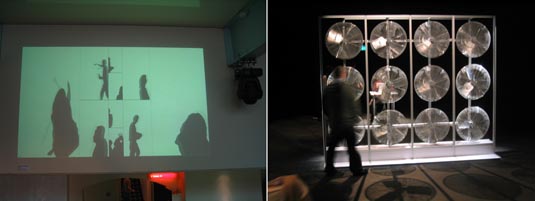

 subscribe
subscribe
Scott Snibbe's exhibition Body, Space and Cinema, at the ICA is a retrospective of his work which spans nearly 10 years.
What I found interesting about Scott Snibbe is the user-friendliness of his work, which can be appreciated on many different levels. On the one hand you have its simplicity, inviting child-like play; on the other hand you have its philosophical and phenomenological roots which gives his work more depth. Ultimately, this means his work is accessible to all. As he later confirms, the most important thing for him is in engaging as many people as possible.
I think the reason for this is the clarity of cause-and-effect in his work, an aspect of many contemporary digital art installations, which is not always clear.
Outward Mosaic (2006) (below left) is the first, and most recent of Scott Snibbe's work, which you will experience at Body, Space, and Cinema. Interestingly positioned in ICA's bar area (public rather than gallery space), an overhead screen projects your shadow as recorded by a camera moments beforehand. A sequence is recorded and looped until this loop is intervened by new motion in the camera's field of vision. The screen is split into 12 symmetrical cubist style boxes, each box showing a portion of that video recorded. Interaction is created once you realise what is going on and you feel obliged to make your own shadow performance as if to prove to yourself about the interaction taking place. Some perform more than others.
As with all Snibbe's work, the point seems to be in manifold transformations: the transformation of life into a work of art; of abstract into the real; the invisible into visible and the real transformed into the flat.
The smaller room downstairs has a number of computers where Snibbe's physical installations are transferred to the desktop. In Tripolar (2002), It's Out (2001), Gravilux (1999), Myrmegraph (1999) and Bubble Harp (1998) the movement of the mouse now replaces the movement of the body. These interfaces give you a feeling of what is at the essence of Snibbe's work, but the overall effect is diminished. Naturally, this kind of human-computer-interface gives such artists an important outlet for their work via the Internet.

Blow Up (2005) (above, right) represents another aspect of the artists work. This time no shadows; no projections onto silver screens but equally as rooted in deep, conceptual theory and based on the idea of cause and effect. A Steel structure stands in the middle of a darkened room. The structure consists of 12 (4x3) fans which seem to be whirring randomly, but we discover this mechanics is controlled by a small unit, a mini replica of the larger fans, operated from the corner of the room (the viewing position). By blowing these mini fans, their parent version is turned on.
During a presentation and discussion, Snibbe's approach to explaining can be compared to his work itself: moving from the complex to the child-like in engaging the audience with the some of the philosophical complexities so central to his conceptual artworks, yet often operating at a child-like level.
His creative approach is such that he views process as being more important than the product. He sees his work as subtractive; where he strips away his work to its simplest form, leaving the most basic components.
Snibbe is also the first to admit, that his background in computer software is mainly in production of "useless programs" - programs based on phenomena or ideas rather than productivity. However it is through these useless programs that he tries to understand human interaction.
Snibbe tells us that he is struggling to find a commercial outlet for his work, a worrying fact for a student of interactive digital media. His work has been brought by science museums but he tells us if he can’t sell his work then he may soon have to stop producing this kind of work. Maybe I shouldn't take too much from this but it seems he is a very successful and well-respected artist in this area and if he can’t afford to carry on, what hope is there for any of us?